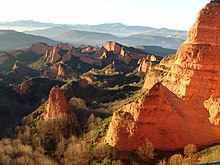Ruina montium (Latin, "wrecking of mountains") was an ancient Roman mining technique described by Pliny the Elder (Natural History 33.21), who served as procurator in Spain.[1][2] It is thought to draw on the principle of Pascal's barrel.[3] Miners would excavate narrow cavities down into a mountain, whereby filling the cavities with water would cause pressures large enough to fragment thick rock walls.[4][5][6]

See also edit
References edit
- ^ Pliny the Elder (1857) with John Bostock and H.T. Riley, trans., The Natural History of Pliny (London, England: Henry G. Bohn), vol. 6, Book 33, Ch. 21, pp. 101–104.
- ^ John F. Healy (1999). Pliny the Elder on Science and Technology. Oxford University Press. pp. 275–290. ISBN 978-0-19-814687-2.
- ^ Ancient Engineers' Inventions: Precursors of the Present (Springer, 2009), p. 135.
- ^ Rossi, Cesare; Russo, Flavio; Russo, Russo (2009). Ancient Engineers' Inventions. Vol. 8. Springer. pp. 133–141. ISBN 978-90-481-2252-3.
- ^ Cesare Rossi; Flavio Russo (26 August 2016). Ancient Engineers' Inventions: Precursors of the Present. Springer. pp. 185–192. ISBN 978-3-319-44476-5.
- ^ Alfred Michael Hirt (25 March 2010). Imperial Mines and Quarries in the Roman World: Organizational Aspects 27 BC-AD 235. OUP Oxford. pp. 32–45. ISBN 978-0-19-957287-8.